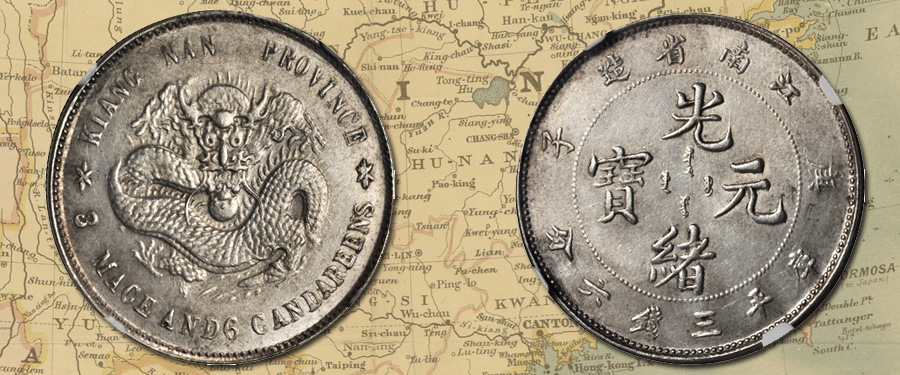
The Stack’s Bowers and Ponterio April Hong Kong Showcase Auction is now live! The entirety of the sale can now be previewed online, complete with full lot descriptions and high-resolution images. This week’s preview lot is an especially rare provincial issue, a Kiangnan 1900 3 Mace 6 Candareens. Though the reason is not totally clear, in most references the Half-Dollar sized emissions from Kiangnan are all considered scarce and rare. In his reference Eduard Kann makes the statement, "…this denomination proved at no time popular in the Nanking-Shanghai districts. Therefore, the 50-cents piece marked KIANGNAN is rare…" In the "Catalogue of the Collection of Chinese Exhibits at the Louisiana Purchase Exposition, St. Louis 1904" it states: "Of the half dollar pieces only a few were coined, and they never got into general circulation, but were taken up privately." Thus it would seem that the Kiangnan 50 Cent pieces were not minted in any significant number, and while it is doubtful that collectors tucked all of the minted pieces away, their use in general circulation was certainly very limited. The reason for this limited circulation would seem to be the fiscal systems used in common trade at the time. While the dragon Dollar coinage was initially begun as a way for the Chinese government to replace foreign silver coins with domestic coinage, the proliferation of provincial mints that sprang up in the late 1800s caused a backlash. The size, weight and fineness of coins from mint to mint was not consistent and coins, which were minted in different provinces, were viewed with suspicion when used in other regions. Additionally, the intrinsic value of the fractional coinage was not consistent with the intrinsic value of the Dollars they were meant to be a portion of, so the common custom was to value minor coinage at a different ratio to Dollars, i.e. eleven or twelve 10 Cent pieces could be exchanged for a Dollar. Given this rate of exchange, it is evident that the 50 Cent pieces would be rarely used, while the 20 and 10 Cents would be in great demand. This exchange system varied from region to region as the fineness and weight of the various mint issues dictated, so while 50 Cent pieces were unpopular in places like Kiangnan, other areas like Kirin and Yunnan minted 50 Cent coins in great quantities for many years. Additionally it should be noted that the Kiangnan 50 Cent coin design was never updated to the newer style of dragon that began with the Dollar and 20 Cent size coins in 1899. This adds to the evidence that 50 Cent pieces were of a lower priority in overall mint production. This piece represents the rare final year of only three total years of minting.
The obverse design features the archetypal symbol for China, the eastern serpentine dragon. The dragon displays a fearsome visage, its great scaly form winding and twisting in flight. Its four limbs, tipped with fierce claws appear equidistant from each other in a square pattern. Wisps of clouds surround the dragon, providing visual markers of its presence in the sky. Long whiskers drape down past its open mouth, with an ornate flaming pearl issuing from its mouth. The flaming pearl contains three dots. Around the motif of the dragon, the English legend: “KIANG-NAN PROVINCE” appears above, with “3 MACE AND 6 CANDAREENS” (Denomination) appearing below. The upper and lower legends are separated by two six-petal rosaces.
The reverse design features an all Chinese and Manchu legend, which follows the usual pattern, the upper portion stating: “Made in Hupeh Province” and the lower legend indicates the denomination of 3 Mace 6 Candareens (50 Cents). A pearled border separates the legend from the central inscriptions. The central inscription states: “Kuang-Hsu Yuan-Pao” meaning “Valuable Coin (of the) Kuang Hsu (regime),” with a smaller Manchu inscription in the direct center.
Look for this and other Asian and world numismatic rarities in our upcoming April Hong Kong Showcase Auction. Preview this impressive coin along with the rest of our auction this March at the Stack’s Bowers and Ponterio office located in Irvine, California. For details please refer to the Events Calendar link at www.StacksBowers.com. To schedule an appointment, please call 800.458.4646. While our Stack’s Bowers Galleries April Hong Kong Showcase Auction is no longer open for consignments, we are currently taking consignments of ancient and world coins for our August 2015 ANA World’s Fair of Money Showcase Auction and Asian coins and currency for our August 2015 Hong Kong Showcase Auction. If you are interested in consigning your coins and paper currency (whether a whole collection or a single rarity) be sure to contact one of our consignment directors.





